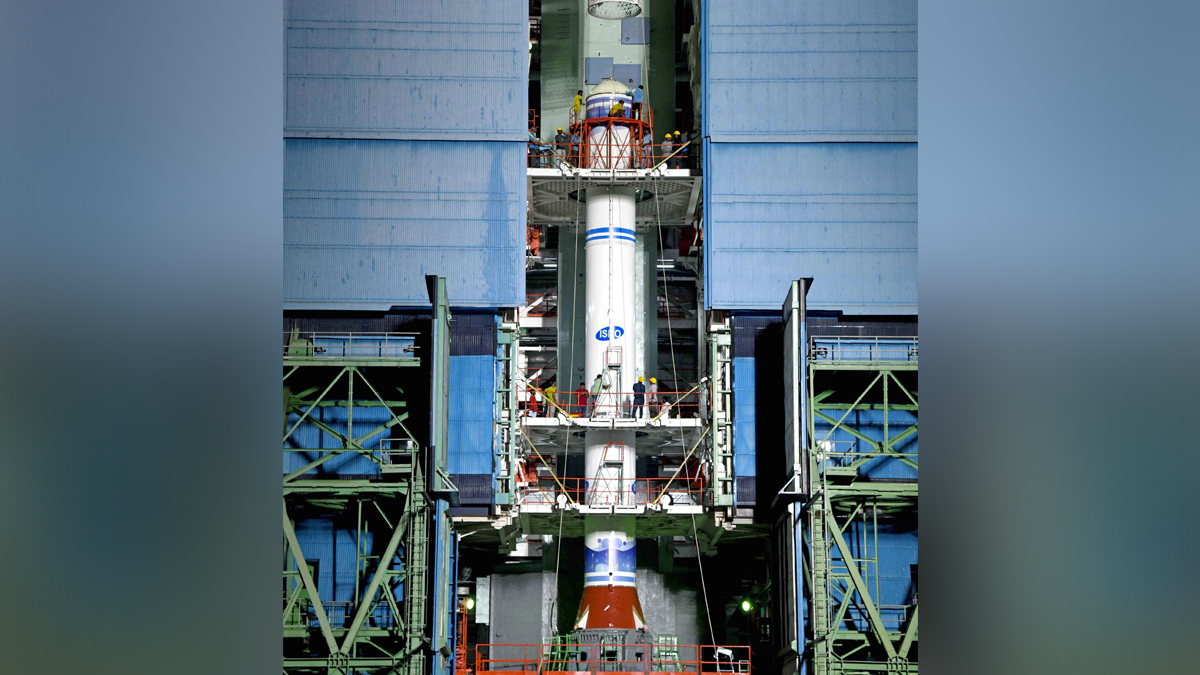The Indian Space Research Organisation (ISRO) is gearing up to launch the Earth Observation Satellite-08 (EOS-08) on Friday at 9:17 am using the third developmental, Small Satellite Launch Vehicle (SSLV)-D3. The launch is planned to occur at the Satish Dhawan Space Centre in Sriharikota, Andhra Pradesh.
This is the third developmental flight (SSLV-D3), the first one being the SSLV-D1 which was launched on August 7, 2022, carrying the Microsat 2A and AzaadiSAT satellites. Unfortunately, it did not achieve its goal of placing the satellites in their intended circular orbit due to a sensor failure that the ground control teams did not detect.
The second SSLV development flight, SSLV-D2, took place on February 10, 2023. This mission successfully launched the EOS-07 (Earth Observation Satellite-07), Janus-1, and AzaadiSAT-2 satellites into an orbit 450 kilometres above Earth.
Why is this launch special?
Space experts say that the SSLV is a three-stage rocket, with the first three stages powered by solid propellant. The final stage, known as the terminal stage, features a liquid propulsion system called the Velocity Trimming Module (VTM) and a payload adapter. The VTM is used to adjust the rocket's speed when needed, while the payload adapter securely attaches the payloads to the top of the rocket, ensuring their safe delivery into space.
The VTM makes adjustments by releasing small amounts of liquid fuel to create thrust. This thrust can either increase or decrease the rocket's speed, allowing precise control over its velocity. By carefully managing these bursts of thrust, the VTM helps guide the rocket into its intended orbit.
The rocket is 2.1 meters wide and 34 meters long, with a liftoff weight of about 120 tonnes. It offers different options for mounting various types of satellites, including nanosatellites (1 to 10 kilograms), microsatellites (10 to 100 kilograms), and mini-satellites (100 to 500 kilograms).
SSLV-D3/EOS-08 Mission:
— ISRO (@isro) August 13, 2024
Citizens are invited to witness the launch from SDSC-SHAR, Sriharikota by registering here from 6 pm IST, todayhttps://t.co/J9jd8ymp2a
Brochure: https://t.co/LQ5Sbgd937 pic.twitter.com/1jzA7yu0fe
“The SSLV can be launched quickly when needed, allowing ISRO to serve the growing market for small satellite launch services efficiently. This launch vehicle can send one satellite weighing up to 500 kg into a planar orbit, 500 km above the Earth and is capable of conducting six to eight missions each year,” said space expert Girish Linganna.
Additionally, it can carry up to three different satellites, with weights ranging from 10 to 300 kg, to the same 500-km orbit, he added.
Also read
- Amid opposition’s ‘hacking’ claims, PM Modi lauds EC for using technology to empower voters in Mann ki Baat
- SpaDeX mission: Why ISRO's successful docking a giant leap for Indian space exploration?
- 'Exciting handshake': Two satellites launched by ISRO for space docking close in to 3 metres in trial attempt
A planar orbit is a flat, horizontal path around the Earth, allowing satellites to maintain a consistent altitude and position relative to the Earth's surface. The rocket can transport payloads of up to 500 kg to low-Earth orbit (LEO) and up to 300 kg to sun-synchronous orbit (SSO).
Low Earth Orbit (LEO), ranging from 160 to 2,000 km, hosts Earth observation, communication, scientific satellites, and space stations like the ISS. Sun-Synchronous Orbit (SSO), typically 600 to 800 km high, is ideal for satellites needing consistent lighting, such as Earth observation, remote sensing, and weather satellites.
“The SSLV is designed to be a cost-effective choice for launching into space. It offers the flexibility to carry multiple satellites and can be ready to launch quickly. The SSLV requires minimal infrastructure, has a short turnaround time, and can be built faster by industries. It also requires very little time at the launch pad, allowing integration and launch within 24 hours,” remarked Linganna.
The EOS-08 satellite is created to improve monitoring of the environment, aid in managing natural disasters, and support the Gaganyaan mission. The Small Satellite Launch Vehicle (SSLV) development project by ISRO has been completed with SSLV-D3. Designed to launch small satellites, SSLV will now move to regular missions managed by Indian companies and NewSpace India Limited (NSIL). This shift enhances private sector involvement in India's space industry and boosts satellite launch capabilities.
The satellite carries three payloads namely the Electro-Optical Infrared Payload (EOIR), the Global Navigation Satellite System-Reflectometry (GNSS-R) payload, and the SiC UV Dosimeter.
EOIR is a device that captures images using infrared light, specifically in the Mid-Wave Infrared (MIR) range of 3-5 micrometres and the Long-Wave Infrared (LWIR) range of 8-14 micrometres, making it useful for surveillance, disaster monitoring, fur detection, volcanic activity and environmental studies both during the day and at night.
On the other hand, the Global Navigation Satellite System-Reflectometry (GNSS-R) is an instrument that uses signals from satellites to study various environmental factors, such as ocean winds, soil moisture, floods and inland waterbody detection. Then there is the SiC UV Dosimeter which is a sensor that detects ultraviolet radiation and alerts for high levels of gamma radiation, helping to keep astronauts safe.
“EOS-08 is built on the Microsat/IMS-1 bus, which is a compact and efficient satellite platform designed for small satellites. It operates in a circular low Earth orbit at an altitude of 475 kilometres and an inclination of 37.4 degrees. The satellite weighs about 175.5 kilograms, generates around 420 watts of power, and is designed to function for one year,” said Linganna.
“EOS-08 marks a major step forward in satellite technology by featuring an Integrated Avionics system. This system, called the Communication, Baseband, Storage, and Positioning (CBSP) Package, combines essential functions like communication, data processing, storage, and positioning into one unit. This integration improves efficiency and performance, making the satellite more capable and reliable,” he pointed out.



